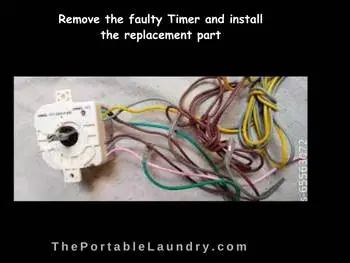Locate the timer switch with the help of your washing machine’s user manual before replacing it. Typically, they are located behind the control panel’s console and are connected to the washer’s knobs. Next, detach the panel, unscrew the timer switch frame, and remove the electrical wires to unmount and replace it with the new timer switch.
This is easier said than done, isn’t it?
Let’s take a deeper look at the entire process, step by step.
Key Takeaways
- Timer switches are located behind the control panel’s console and control the majority of the washer’s functions.
- Always turn off the washer before unscrewing the retaining screws in the control panel.
- Make sure to detach the wires safely and make a note of the wire location so that the next time you replace the switch, you know exactly where to attach the wires.
What is a washing machine timer?
The timer switches control how long the wash program lasts, based on the duration you assign to it.
It controls most of the washer’s functions, and in the event of any damage, it can make your washer act weird.
Changing wash cycles and agitation or spinning are all controlled directly or indirectly by the timer switch.
The commands you set through the washing machine’s selector knob are directly assigned to the timers.
A faulty timer can lead to skipping an entire cycle of the selected wash program. For example, your washing machine may skip the rinse or spin cycles depending on the laundry program you select.
Surprisingly, these timers, being tiny pieces of equipment, have a lot of tiny gears and wires in them.
Note: In some washing machines, the timer switch includes two outlets for knobs in a single frame. One is the wash program selection (The Selector Knob) and the other one is to set the wash duration, i.e., the timer. Moreover, some washers may have two interconnected timers installed and can be identified through the user manual.
Where is the timer switch located in a washing machine?
A washing machine timer is typically located behind your washer’s control panel frame. Washing machines or dryers that use a rotating knob are directly connected to the timer switch placed on the opposite side behind the panel.
Digitally operated machines with a touch panel use sensing technology to alert the timer switch.
For proper accuracy in locating the types of timer switches, simply refer to the user manual of your washing machine model and type.
How does the timer switch wear out?
Washing machine timers can wear out for a variety of reasons, and there is no one cause.
Having said that, here are some common causes of a damaged timer switch.
- It may wear out due to a malfunctioning sensing system or even due to excess vibration.
- if your washer was not handled carefully during transit, the internal parts can be loosened.
- You can even damage the timer switch by rotating the timer or the selector knobs roughly or by using excessive force.
- Over time, the gears inside the timer switch can get caught, resulting in a malfunctioning timer.
- A damaged electrical cable connected to a timer switch can also cause the timer to malfunction.
- Timer switch malfunctions can also be caused by power fluctuations.
So, there are endless reasons why the timer switch could fail.
How to replace the timer of a washing machine and dryer?
Step 1: Disconnect the Supplies

Turn off the water supplies and unplug your washing machine from the power source.
If the replacement process demands moving your machine, then don’t forget to disconnect the water inlet and drain hoses.
Caution: Do not miss out on unplugging the washer from the power outlet to prevent yourself from getting an electric shock.
Step 2: Remove the holding panels

Unscrew the retaining screws from the control panel, which is usually located at the back of the washer.
After removing the screws, gently push the holding clips out of their frame using a flathead screwdriver.
Step 3: Remove the faulty timer

Remove all the electrical wires that run towards the buzzer, control panel, and other components.
While doing so, do not forget to make a note of the wires that run from the timer to the destination components.
In most cases, you will find 5 to 7 wires depending on your washer’s model and type.
The timers are usually fixed using a couple of screws that need to be removed.
Tip: You can identify or mark them as per the color of the electrical wires and their length. In most cases, these wires are different in color and may vary in length.
By doing this, you won’t confuse yourself while assembling the replacement timer switch.
Pull the timer out of the frame, and for some washers, you will have to remove the knobs from the opposite end.
Additionally, some washing machine timers include all the wires in a single harness. This wire harness is directly attached to the timer’s inlet.
Simply remove the harness that accommodates the wires to disconnect them from the faulty timer.
Step 4: Install the replacement Timer Switch
Place the new Timer switch to its position and fix the knobs from the opposite end if applicable.
Connect the electrical wires to their desired components.
Or simply plug the wire harness into the timer’s inlet slot firmly.
Now tighten the timer’s retaining screws firmly to the console.
Step 5: Re-assemble the washer
Attach the panels by reversing the steps and connecting the water supplies and the drain.
Run a test cycle to ensure it works as usual.
Final Thoughts
Timers are an important component of your washing machine or dryer.
A faulty timer can put the entire machine to a halt, so replacing them becomes a must if they get damaged.
Always refer to the user manual of your washing machine to identify its location and the replacement instructions, if any.
Lastly, make sure to buy a suitable replacement timer. This can be done with the help of the model number of your machine.
Frequently Asked Questions
Do all washing machines use the same timer switch?
The mechanisms may be similar, but they differ depending on the type and model of the machine. So the answer is no, the timer switches are not the same for every washing machine.
How do you know if the timer on your washer is broken?
Missing cycles, timer not advancing, stalling in mid-cycle, and wash cycle taking too long to complete, are all common symptoms of a broken or faulty timer. So, check your timer if you notice any of these symptoms.
How much does a washing machine timer cost?
A washing machine timer may cost anywhere from $45 to $150, depending on the brand and model. However, some may be cheaper or more expensive depending on the location and time of the sale.
You May Also Like
- How to replace the buzzer in a washing machine?
- How to Replace Washing Machine Capacitor? (Step-by-Step)
- How To Replace Tub-To-Pump Hose In Washing Machine?
- How To Replace The Drain Hose In Washing Machine?
- How To Replace Washing Machine PCB Board?
- How to Replace The Outer Panels Of A Washing Machine?
- How To Replace The Door Of Your Top Load Washer?
- How To Replace The Washing Machines Detergent Drawer?
- How to replace the Inner Tub of a Front-Load Washing Machine?
- How To Replace The Gearbox In a Washing Machine?
- How to Transport a Washing Machine Safely?
- How to Install Waste Pipe for Washing Machine? (Step-by-Step)
- How to Install a Washing Machine Drain Pan?





